Welcome to another Friday Field Strip. Watch the Field Strip video below, then read the article below…
The Thompson submachine gun is perhaps one of the most recognizable and important American firearms of all time. Most people in the United States could recognize the “Tommy Gun” if shown a picture of the distinctive earlier models, equipped with their large drum magazines, foregrip, and compensator. It’s a notorious firearm, closely associated with gangsters, crime, and Prohibition which carries a reputation as “the gun that made the Twenties roar”. It was designed by a team assembled by then-Colonel John T. Thompson as a trench clearing weapon for World War I, but was finished just days too late for that conflict. In fact, it was used during the 1920s and early 1930s by both gangsters and police alike, and offered a degree of handheld firepower that was unmatched by any contemporary weapon, although its high price tag (about half the cost of an automobile at the time) made it less popular than is usually depicted in films and television shows. The use of Thompson submachine guns by criminals in fact helped lead to the 1934 National Firearms Act, which heavily regulated the sale and transfer of fully automatic weapons in civilian hands. The Thompson was the first US submachine gun, arguably the first true submachine gun, and the first weapon actually called a “submachine gun” (in fact, as point of trivia, it was the early Auto-Ordnance advertisements that established the style “submachine gun”, rather than “sub-machine gun” or “sub-machinegun”).

The M1A1 Thompson, 30 round magazine inserted, is a very large, very heavy weapon for its class. Fully loaded, like this, it weighs about twelve and a half pounds. Image courtesy of Alex C.
The early history of the Thompson and its use as a gangster and police weapon will not be the central focus of this article. Rather, we will focus on the Thompson’s history in uniform, as a weapon of war. The first postwar attempt to interest war-weary military customers in the new submachine gun was the Model of 1923. This “military model” was similar to the Model of 1921, but also sported a bipod for prone use. Two variants of the military model apparently exist, a 14.5″ finless heavy-barreled model with both bipod and bayonet lug, and a variant with a simplified 10.5″ finned barrel, similar to the Model of 1921’s. This variant was also offered in a new round, the .45 Remington-Thompson, which used a longer .998″ case, and fired a 250gr bullet at 1,450 ft/s. None of the 1923 military models found military orders, although what appears to be one has made its way to China, where it apparently served with Communist forces.

Far right: The .45 Remington-Thompson. Second from right is a .45 ACP shot load designed for riot control. Image source: oldammo.com
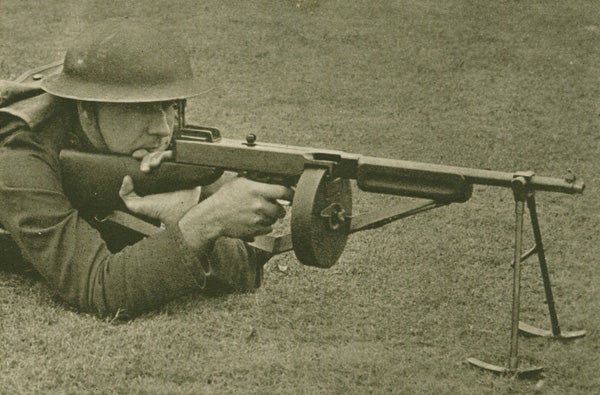
The 1923 Thompson military model, in .45 ACP with an L-drum. Note the bipod. Image source: rubej.at.ua
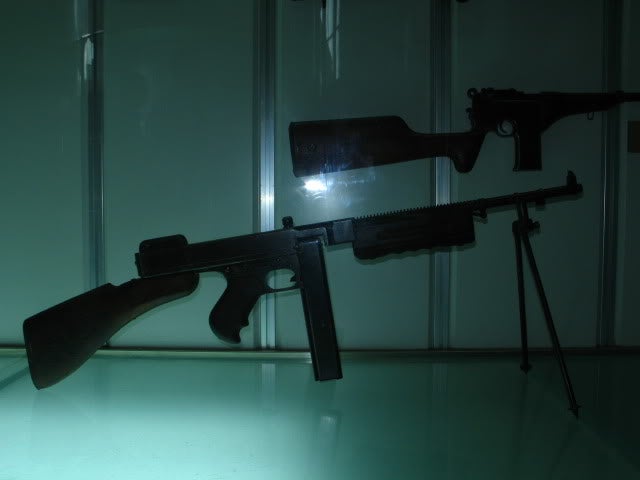
A Thompson submachine gun in the Beijing Military Museum. It bears markings indicating its use by the Chinese Communists, and resembles the 1923 Military Model closely. However, it may be a Chinese invention. Image source: usmilitariaforum.com
By the second half of the 1920s, the Thompson found purchase with military forces. In 1926, at the height of Prohibition, the Marine Corps was ordered to guard the U.S. Mail service after a series of violent mail hijackings. The presence of Marines armed in part with Colt-made Model of 1921 Thompsons quickly made the Mail service too hard a target for outlaws and would-be criminals. By 1928, the Thompson was seeing use in Central America with US Marines fighting the EDSNN rebels of Augusto Sandino; future Medal of Honor recipient Merritt “Red Mike” Edson and five-time Navy Cross recipient Lewis “Chesty” Puller both used Thompsons in Nicaragua before the end of US involvement there in 1933. From 1926-1928, the US Marine Corps bought 671 Thompson Submachine Guns from Auto Ordnance.

US Marines, one with a Model of 1921 Thompson, guard a US Mail plane, while goods are loaded into the Curtiss Model 40 Carrier Pidgeon. Image source: hickeysite.blogspot.com
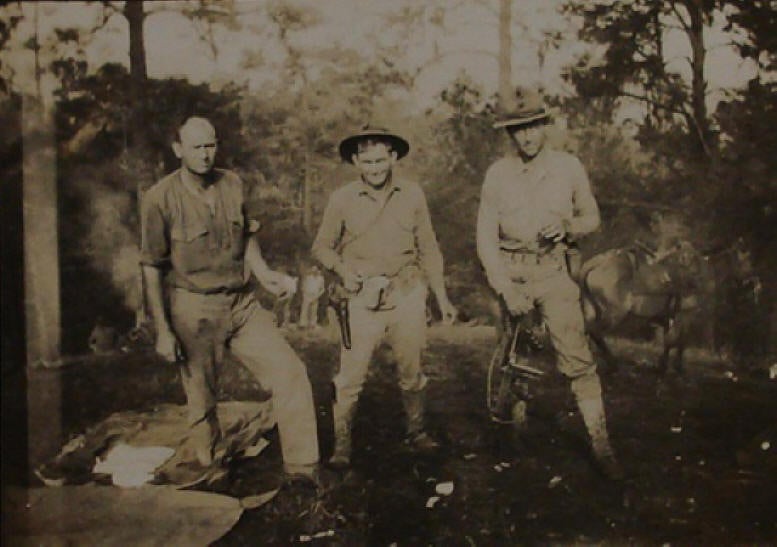
US Marines in Nicaragua, one of which has a Model of 1921 Thompson Submachine Gun. Image source: sandinorebellion.com
During this period, Colt modified a large number of Model of 1921 guns with Cutts compensators, improved spring and spring guide assemblies, and heavier actuators (cocking handles) to slow the firing rate from 800 to 600 rounds per minute. Striking out earlier markings, Colt created this model at the request of the Navy, therefore the new markings read “U.S. NAVY MODEL OF 19218″, and are commonly called the Model of 1928 Navy. These represent one of the first modifications made for a military customer, and would be the pattern for the military Thompson until the M1928A1, as well as being Colt’s most produced variant. Some Model of 1928 Navys did go to the United States Navy, but most were actually sold abroad to foreign governments and police departments. It was this model that would interest the U.S. Army for the first time as well, being procured in 1932; these first Army Thompsons were ironically also the last U.S. Army weapon type to be designated according to the old Model-Year system; all subsequent weapons, including the later simplified Thompsons would use the M-Number system still in use today.

A British Army soldier tests a Model of 1928 Thompson with a purpose-built motorcycle mount. Image source: royalenfields.com
In 1939, the Savage Arms Company entered a contract with Auto Ordnance to begin producing Thompsons to fill the increasing demand for foreign military orders, chiefly an order placed by the British and French governments. Savage guns began rolling off the line in April of 1940, and while French capitulation would follow soon after, the British purchased 108,000 guns from 1940-1941, at an initial price of $175 a piece. During this period, the Model of 1928 Thompson underwent a few minor changes to the ejector and compensator, but would not undergo a major designation change until March of 1941, with the passage of the US Lend-Lease Act. This act essentially traded materiel and supplies for temporary use of foreign bases during wartime, and it also ended British orders for the Thompson. Instead, the US government assumed ownership of the guns going to foreign militaries, and provided by the Act was that the guns had to be marked as U.S. Property and U.S. Model of 1928 A1. So far as I know, the Lend-Lease Act was the only reason for the change to the A1 designation, though some minor changes to the weapon did occur throughout production thereafter.

Soviet Naval Infantry with M1928A1 Thompsons during the Second World War. Image source: guerrayhistoria.wordpress.com
The demands of wartime production quickly made it obvious that the M1928A1 Thompson as it then existed was far too complicated and expensive to make to be a suitable arm for the wars of economy then raging in Europe and Japan. In November of 1941, Savage engineers studying the problem outlined the elements of the Thompson’s design that were most expensive to produce, chief among them being the rails in the receiver for the bronze Blish lock, and three-piece bolt assembly. The existence of successful blowback submachine gun designs in Europe made it clear that both of these elements could be dispensed with without sacrificing safe and reliable function of the gun. Savage engineers presented the simplified Thompson to Ordnance Department evaluation in February of 1942, which concluded soon thereafter. The Aberdeen report on the gun determined that it was as good a design as the original M1928A1, and suggested a few changes, which were then incorporated. Savage assured Auto-Ordnance that the redesigned Thompson was not an effort on their part to seek compensation or royalties, or more importantly, patents. In March of 1942, Ordnance recommended the adoption of the new design as the Submachine Gun, Cal. .45, M1, and the reclassification of the M1928A1 as Limited Standard. In late April, this recommendation was approved.
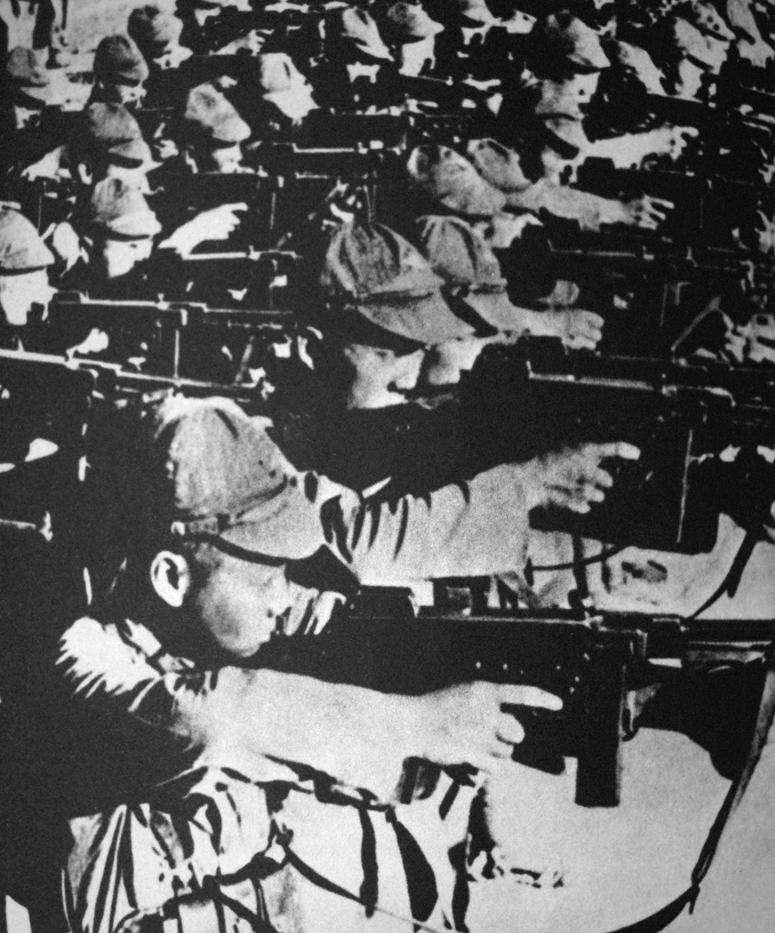
Chinese soldiers, most likely Nationalists, with Thompson Submachine Guns. Image source: bbs.smilekrub.net
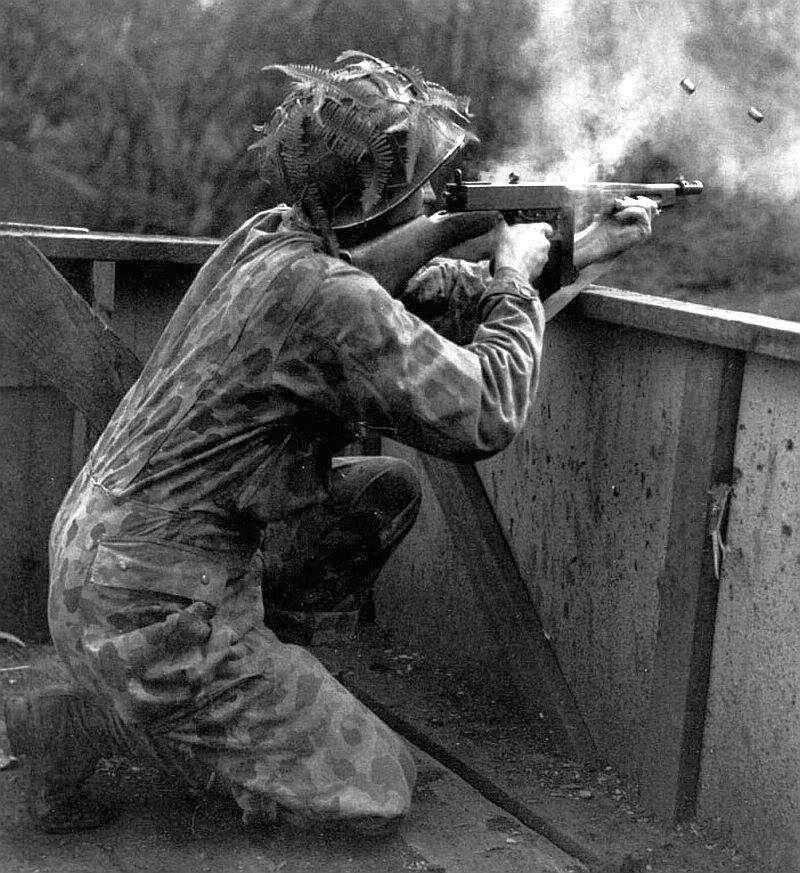
A soldier from the 82nd Airborne fires his late-model M1928A1 Thompson in North Africa. He wears a jumpsuit in the M1942 camouflage pattern. Image source: mmzone.co.kr
Savage engineers continued work, however, creating a test model called the M42, which was modified from an M1 by the removal of the firing pin spring and hammer, with the firing pin fixed in the forward position. Less than a hundred M42s were made, when production was altered to a version with firing pin machined from the bolt face itself. This design was successful, and by September of 1942, Aberdeen Proving Grounds was given one of these guns for testing, finding it superior to the M1 in function, durability, and machining time. Further, the bolts of the M1 and the modified version were interchangeable between variants. As a result, two days before Halloween of 1942, Ordnance approved the new modifications as the Submachine Gun, Cal. 45, M1A1.

Unlike all previous models, the M1 and M1A1 lack the ability to use drum magazines, and therefore feature a straight cutout for the magazine, without the horizontal T-slot for mounting L and C drums. Image courtesy of Alex C.
Concurrently, however, the US Army was working on another, even cheaper weapon to replace the still expensive M1 submachine gun. This would become the M3, and in January of 1943, the Ordnance Department told Auto-Ordnance that M1 production would be concluded by July of 1943. The orders currently placed were reduced, but by June authorization had been given for Ordnance to place an order for 60,000 more M1s before the end of August, which was then nearly doubled. Several thousand guns were then assembled from spare parts in early 1944, and production briefly restarted in February of that year to produce an additional 4,091 guns. The last M1A1 Thompson was produced on February 15, 1944, concluding the type’s production history. At the beginning of M1928A1 Thompson production, the weapon cost $205 to make, but by the end of M1A1 production, unit cost was down below $43 per unit. M1 Thompsons of both variants would serve the US and allies until the end of the war.

The fire control on the M1A1. The safety and selector both are late rod-type switches, which were cheaper than the early paddle-type switches. Image courtesy of Alex C.
Due to the extensive history of the Thompson Submachine Gun, this post must be limited in scope to the production history for the military until 1945. After the war, Auto Ordnance was sold several times, but eventually production of the fully automatic Thompson did start again, and semi-automatic variants are being made today. The type had a long and colorful service history with many nations after 1945, which deserves its own post, but which I am unable to include here as this article is already longer than it should be. Perhaps another day.
Much of the information in this article was gleaned from Frank Iannamico’s excellent series of articles on the weapon for Small Arms Review. I have done my best to present the history in my own words, while preserving the original quality of the information. If this article interested you, please head over to Small Arms Review via the links below to read those articles (the eighth part of which concerns production by Numrich Arms Corp in the 1970s, and is unfortunately missing):
THE THOMPSON SUBMACHINE GUN ID GUIDE, PART I: THE THE COLT AND SAVAGE 1921-1928 MODELS
THE THOMPSON SUBMACHINE GUN ID GUIDE, PART III: THE COLT THOMPSON SUBMACHINE GUN
THE THOMPSON SUBMACHINE GUN ID GUIDE, PART IV: THE SAVAGE ARMS THOMPSON
THE THOMPSON SUBMACHINE GUN ID GUIDE, PART VI: THE M1 THOMPSON SUBMACHINE GUN
THE THOMPSON SUBMACHINE GUN ID GUIDE, PART VII: THE M1A1 THOMPSON SUBMACHINE GUN
THE THOMPSON SUBMACHINE GUN ID GUIDE, PART IX: THE MILITARY THOMPSON DRUM MAGAZINE
THE THOMPSON SUBMACHINE GUN ID GUIDE, PART X: THE THOMPSON DRUMS OF WEST HURLEY, AUTO-ORDNANCE
 Your Privacy Choices
Your Privacy Choices